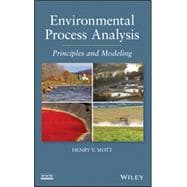
What is included with this book?
HENRY V. MOTT, PhD, Professor Emeritus of Civil and Environmental Engineering of the South Dakota School of Mines and Technology, is now a consultant in private practice and part-time instructor for the Civil Engineering Department of the University of Minnesota. Dr. Mott has developed and delivered a broad range of undergraduate and graduate courses, drawing upon his engineering practice experience to develop opportunities for students to apply fundamental principles in problem solving and design. His research has focused on contaminant fate and transport, physical/chemical/microbial processes, and environmental chemistry.
Chapter 1 Introductory Remarks
1.1 Perspective
1.2 Organization and Objectives
1.3 Approach
Chapter 2 Water
2.1 Perspective
2.2 Important Properties of Water
Chapter 3 Concentration Units for Gases, Liquids and Solids.
3.1 Selected Concentration Units.
3.2 The Ideal Gas Law and Gas Phase Concentration Units.
3.3 Aqueous Concentration Units.
3.4 Applications of Volume Fraction Units.
Problems
Chapter 4 The Law of Mass Action and Chemical Equilibria.
4.1 Perspective
4.2 The Law of Mass Action.
4.3 Gas/Water Distributions.
4.4 Acid/Base Systems.
4.5 Metal Complexation Systems.
4.6 Water/Solid Systems (Solubility/Dissolution)
4.7 Oxidation/Reduction Half Reactions.
Chapter 5 Air/Water Distribution: Henry’s Law..
5.1 Perspective
5.2 Henry’s Law Constants.
5.3 Applications of Henry’s Law..
Problems
Chapter 6 Acid/Base Component Distributions.
6.1 Perspective
6.2 Proton Abundance in Aqueous Solutions – pH and the Ion Product of Water
6.3 Acid Dissociation Constants.
6.4 Mole Accounting Relations.
6.5 Combination of Mole Balance and Acid/Base Equilibria.
6.6 Alkalinity, Acidity and the Carbonate System..
6.7 Applications of Acid/Base Principles in Selected Environmental Contexts.
Problems
Chapter 7 Mass Balance, Ideal Reactors, and Mixing.
7.1 Perspective
7.2 The Mass Balance.
7.3 Residence Time Distribution (RTD) Analyses.
7.4 Exit Responses for Ideal Reactors.
7.5 Modeling of Mixing in Ideal CMFRs.
Problems
Chapter 8 Reactions in Ideal Reactors.
8.1 Perspective
8.2 Chemical Stoichiometry and Mass/Volume Relations.
8.3 Reactions in Ideal Reactors.
8.4 Applications of Reactions in Ideal Reactors.
8.5 Interfacial Mass Transfer in Ideal Reactors.
Problems
Chapter 9 Reactions in Non-ideal Reactors.
9.1 Perspective
9.2 Exit Concentration versus Time Traces.
9.3 Residence Time Distribution (RTD) Density.
9.4 Cumulative Residence Time Distributions.
9.5 Characterization of RTD Distributions.
9.6 Models for Addressing Longitudinal Dispersion in Reactors.
9.7 Modeling Reactions in CMFRs in Series (TiS) Teactors.
9.8 Modeling Reactions with the Plug-Flow with Dispersion (PFD) Model
9.9 Modeling Reactions using the Segregated Flow (SF) Model
9.10 Applications of Non-ideal Reactor Models.
9.11 Considerations for Analyses of Spatially Variant Processes.
9.12 Modeling Utilization and Growth in PFR-like Reactors using TiS and SF.
Chapter 10 Acids and Bases: Advanced Principles.
10.1 Perspective
10.2 The Activity Coefficient
10.3 Temperature Dependence of Equilibrium Constants.
10.4 Non-ideal Conjugate Acid/Conjugate Base Distributions.
10.5 The Proton Balance (Proton Condition)
10.6 Analyses of Solutions Prepared by Addition of Acids, Bases and Salts to Water
10.7 Mixing of Aqueous Solutions.
10.8 Activity versus Concentration for Non-Electrolytes.
Problems
Chapter 11 Metal Complexation and Solubility.
11.1 Perspective
11.2 Hydration of Metal Ions.
11.3 Cumulative Formation Constants.
11.4 Formation Equilibria for Solids.
11.5 Speciation of Metals in Aqueous Solutions Containing Ligands.
11.6 Metal Hydroxide Solubility.
11.7 Solubility of Metal Carbonates.
11.8 Solubility of Other Metal-Ligand Solids.
Problems
Chapter 12 Oxidation and Reduction.
12.1 Perspective
12.2 Redox Half Reactions.
12.3 The Nernst Equation.
12.4 Electron availability in environmental systems.
Problems
Appendices
ReferencesThe New copy of this book will include any supplemental materials advertised. Please check the title of the book to determine if it should include any access cards, study guides, lab manuals, CDs, etc.
The Used, Rental and eBook copies of this book are not guaranteed to include any supplemental materials. Typically, only the book itself is included. This is true even if the title states it includes any access cards, study guides, lab manuals, CDs, etc.